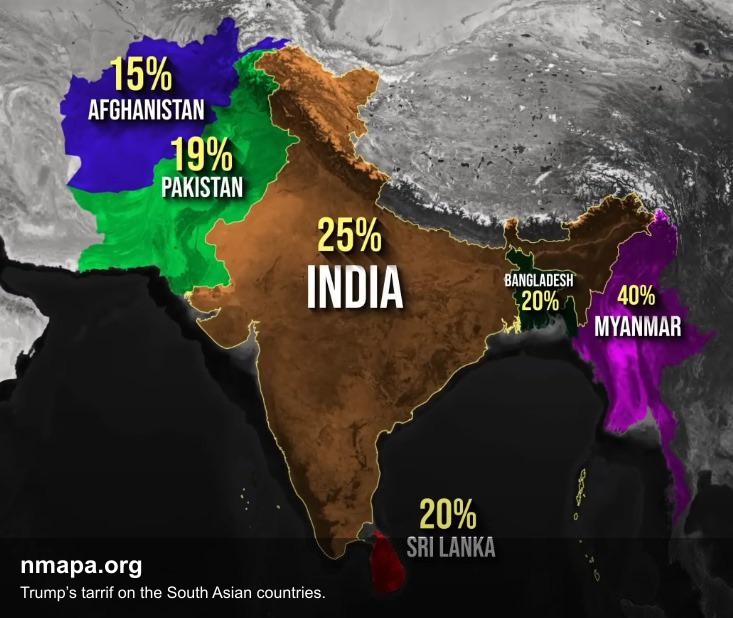Tariff Rates Map of South Asian Countries


Marcus Rodriguez
Historical Geography Expert
Marcus Rodriguez specializes in historical cartography and geographic data analysis. With a background in both history and geography, he brings unique...
Geographic Analysis
What This Map Shows
This map provides a detailed overview of tariff rates imposed by the United States on various South Asian countries. The visualization highlights how these tariffs affect trade relations and economic exchanges between the U.S. and nations such as India, Pakistan, Bangladesh, Nepal, Sri Lanka, and Bhutan. By looking at the tariff rates, one can gauge the economic landscape in terms of import duties and their implications on the broader trade agreements.
Deep Dive into Tariff Impacts on South Asia
Tariffs, essentially taxes imposed on imported goods, play a critical role in shaping international trade dynamics. The current geopolitical climate has led to increased tariffs as nations strive to protect their domestic economies. South Asia, a region characterized by diverse economies and varying levels of development, presents a unique case for understanding the implications of these tariffs.
For instance, India, the largest economy in South Asia, has historically been a significant trading partner for the United States. However, recent tariffs on certain Indian goods have led to a ripple effect. Tariffs on steel and aluminum, for example, have strained trade relations, pushing India to respond with its own set of tariffs on American products. This tit-for-tat response illustrates the intricate nature of international trade where tariffs can impact diplomatic relations as well.
Interestingly, Bangladesh has emerged as a major player in the textile industry, heavily relying on exports to the U.S. The tariffs applied to textiles can drastically affect the economy of Bangladesh, where the garment sector accounts for a significant portion of exports. In 2021, Bangladesh's textile exports to the U.S. were valued at $5 billion, demonstrating just how impactful these tariffs can be on a nation's economy.
Moreover, Pakistan faces its own challenges under the current tariff regime. The country has been struggling with economic instability, and increased tariffs on its agricultural products can further exacerbate issues in a sector that employs a large portion of its workforce. The complexities of these tariffs highlight how interconnected trade ties are, not just economically but socially as well, affecting millions of lives in South Asia.
Regional Analysis
When analyzing the impact of tariffs across South Asian nations, we can observe distinct differences. For example, India and Pakistan, both sharing a tumultuous history, often find themselves in economic competition. The tariffs imposed can fuel this rivalry, impacting not just trade but also political relations.
Bangladesh, in contrast, has benefitted from its strategic position as a textile hub, navigating tariffs more adeptly than its neighbors. The country has been able to negotiate favorable terms, showcasing how some nations can leverage their strengths to mitigate tariff impacts.
Nepal and Bhutan, being smaller economies, often have limited direct trade with the U.S. However, they are impacted indirectly through their larger neighbors. For instance, fluctuations in tariff rates on Indian products can have a cascading effect on Nepal's economy, primarily through trade dependencies.
Sri Lanka, with its strategic location along vital shipping routes, faces its own challenges with tariffs. The country’s tea and rubber exports are highly sensitive to U.S. tariffs, which can affect trade flows significantly.
Significance and Impact
Understanding the implications of tariffs on South Asian countries goes beyond mere numbers; it reflects the complex interplay of international relations, economic stability, and social welfare. As global economies become increasingly interconnected, tariffs can serve as both tools for protectionism and as barriers that stifle growth.
The current trends indicate a shift toward more protectionist policies, which could influence future trade negotiations. Ever wondered why trade wars seem to dominate headlines? It's because tariffs not only affect economic indicators but also the political landscape of nations involved. The repercussions can range from shifts in foreign direct investment to changes in local employment rates.
As we look toward the future, it’s vital to monitor these tariff rates and their implications. The potential for trade agreements and negotiations remains, but understanding the historical context and current climate is essential for predicting outcomes. Countries in South Asia must navigate these waters carefully, balancing domestic needs with international obligations.
In conclusion, tariffs serve as a potent reminder of the complexities of global trade, particularly in a region as diverse and economically varied as South Asia. The impact of these rates will continue to evolve, making it an important area for ongoing study and observation.
Visualization Details
- Published
- August 2, 2025
- Views
- 146
Comments
Loading comments...